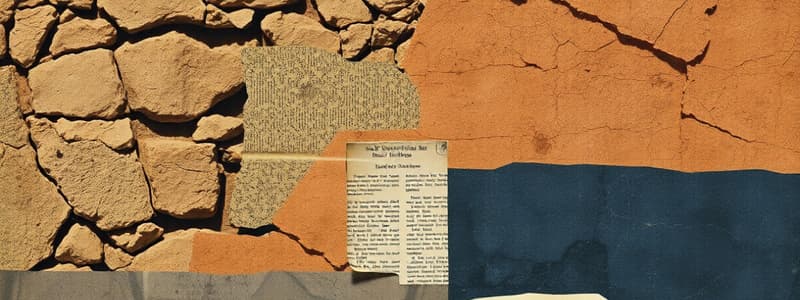Podcast
Questions and Answers
What is the first step in the process of forming sedimentary rock?
What is the first step in the process of forming sedimentary rock?
- Weathering (correct)
- Transportation
- Burial and compaction
- Diagenesis
Which type of sediment is classified as being derived from biological processes?
Which type of sediment is classified as being derived from biological processes?
- Siliciclastic sediments
- Biological sediments (correct)
- Organic sediments
- Chemical sediments
What affects the size, sorting, and rounding of clastic particles?
What affects the size, sorting, and rounding of clastic particles?
- Amount of vegetation in the area
- Temperature of deposition
- Type of minerals present
- Current strength and distance of transport (correct)
In the classification of sediments, which category includes sediments like quartz and feldspar?
In the classification of sediments, which category includes sediments like quartz and feldspar?
Which process occurs after sediments have been deposited?
Which process occurs after sediments have been deposited?
Which environment is characterized by the presence of gypsum and halite due to evaporation of water?
Which environment is characterized by the presence of gypsum and halite due to evaporation of water?
What type of sediment is typically found in siliceous environments?
What type of sediment is typically found in siliceous environments?
What sedimentary structure indicates the direction of current flow in sand deposits?
What sedimentary structure indicates the direction of current flow in sand deposits?
Which of the following environments is likely to have carbonate muds deposited?
Which of the following environments is likely to have carbonate muds deposited?
In what kind of environment would you expect to find peat as a sediment type?
In what kind of environment would you expect to find peat as a sediment type?
Flashcards
Carbonate deposits
Carbonate deposits
Sediments formed from carbonate minerals, often by organisms or inorganic processes in marine environments like reefs, shelves, and beaches.
Siliceous environments
Siliceous environments
Deep-sea environments where silica-rich sediments like those produced by organisms accumulate.
Evaporite environments
Evaporite environments
Environments where water evaporates, leaving behind mineral salts like gypsum and halite, often found in lakes or lagoons.
Sedimentary structures
Sedimentary structures
Signup and view all the flashcards
Cross-bedding
Cross-bedding
Signup and view all the flashcards
Graded bedding
Graded bedding
Signup and view all the flashcards
Bioturbation structures
Bioturbation structures
Signup and view all the flashcards
Bedding sequence
Bedding sequence
Signup and view all the flashcards
Ripples
Ripples
Signup and view all the flashcards
carbonate muds
carbonate muds
Signup and view all the flashcards
Sedimentation
Sedimentation
Signup and view all the flashcards
Weathering
Weathering
Signup and view all the flashcards
Erosion
Erosion
Signup and view all the flashcards
Transportation
Transportation
Signup and view all the flashcards
Sedimentary Rocks
Sedimentary Rocks
Signup and view all the flashcards
Siliciclastic Sediments
Siliciclastic Sediments
Signup and view all the flashcards
Chemical Sediments
Chemical Sediments
Signup and view all the flashcards
Biological Sediments
Biological Sediments
Signup and view all the flashcards
Sedimentary Environments
Sedimentary Environments
Signup and view all the flashcards
Sorting of sediments
Sorting of sediments
Signup and view all the flashcards
Rounding of sediments
Rounding of sediments
Signup and view all the flashcards
Study Notes
Chapter 6: Sedimentation: Rocks Formed by Surface Processes
- Sediments are created on Earth's surface through weathering.
- Sediments are transported and transformed into sedimentary rocks upon settling.
- Sedimentary rocks offer insights into past sedimentary environments.
1. Surface Processes of the Rock Cycle
- Processes forming sedimentary rock:
- Weathering (physical and chemical)
- Erosion
- Transportation
- Deposition (sedimentation)
- Burial and compaction
- Diagenesis
1. Surface Processes of the Rock Cycle - Weathering
- Physical weathering: Disintegration of rocks into smaller fragments without chemical alteration.
- Chemical weathering: Decomposition of rocks through chemical reactions.
1. Surface Processes of the Rock Cycle - Visual Aid
- Figure 6.1 illustrates the processes (weathering, erosion, transportation, deposition, burial, and diagenesis) in cyclical form, visualized with a cross-section of Earth's layers.
- Shows the weathering and erosion of rocks at the surface
- Shows the transportation of materials, such as via streams, wind, or glaciers
- Shows the accumulation of sediments in valleys
- Shows sediments undergoing compaction and lithification.
1. Surface Processes of the Rock Cycle - Classification of Sediments
- Siliciclastic sediments
- Chemical sediments
- Biological sediments
1. Surface Processes of the Rock Cycle - Factors Affecting Transportation
- Current strength and distance of transportation can affect:
- Size of clastic particles
- Sorting of clastic particles
- Rounding of clastic particles
- Figure 6.6 displays images of well-sorted and poorly-sorted sand, illustrating the variation in particle size
- Figure 6.7 shows the rounding of sand grains, dependent on the distance traveled.
1. Surface Processes of the Rock Cycle - Mineral Intensity
- Table 6.1 details the minerals present in sediments derived from granite, differentiating by weathering intensity (low, medium, high).
1. Surface Processes of the Rock Cycle - Chemical Mixing Vats
- Oceans
- Lakes
2. Sedimentary Basins
- Accumulations of sediments in Earth's crustal depressions.
- Depressions form due to subsidence
- Sedimentary basins are the sinks for sediment.
2. Sedimentary Basins - Types
- Rift basins and thermal subsidence basins
- Flexural basins
2. Sedimentary Basins - Visual Aid
- Figure 6.8 provides a diagram illustrating how sedimentary basins develop on rifted continental margins. This shows the process from splitting of the continental crust, to the formation of rift valleys, to the filling of the depression with sediment from shallow oceans.
3. Sedimentary Environments
- Continental: Lakes, alluvial, desert, glacier
- Shoreline: Deltas, beaches, tidal flats
- Marine: Deep sea, continental shelf, organic reef, continental margin and slope
- Figure 6.9 visually outlines these varied sedimentary settings, illustrating their characteristics.
3. Sedimentary Environments - Continued
- Environments of siliciclastic sediments: Continental (alluvial, desert, lake, glacial), Shoreline (deltas, beaches, tidal flats), Marine (shelf, margin, slope, deep sea)
- Environments of chemical and biological sediments: Carbonate deposits (organic reefs, beaches, shelves, tidal flats), Siliceous environments (deep sea), Evaporite environments (lakes).
- Table 6.2 lists major chemical and biological sedimentary environments with their agents of precipitation and resulting sediments.
4. Sedimentary Structures
- All features related to sediments during deposition.
- Bedding or stratification
- Cross-bedding
- Graded bedding
- Ripples
- Bioturbation structures
- Figure 6.11 displays cross-bedding patterns in both deserts and beaches, illustrating their directionality.
- Figure 6.13 exemplifies ripple marks, with symmetrical and asymmetrical patterns.
- Figure 6.12 illustrates modern and ancient ripple marks.
- Figure 6.14 displays bioturbation structures.
- Figure 6.15 is a Visual aid to bedding sequence from different depositional environments
5. Burial and Diagenesis
- Preservation of sediments within a sedimentary basin.
- Physical and chemical changes transforming sediments into sedimentary rocks.
5. Burial and Diagenesis – Lithification
- Compaction reduces sediment volume and expels water.
- Cementation (Precipitation of minerals binding sediments together).
- Figure 6.16 depicts diagenetic processes, including compaction and cementation, and the outcomes of different sedimentary rocks which result from these processes.
6. Classification of Siliciclastic Sediments and Sedimentary Rocks
- Classification of sediments by particle size
- Gravel: Boulder, cobble, pebble
- Sand
- Silt
- Mud
- Clay
- Table 6.3 provides a table about the particle size of sediments and resulting sedimentary rocks, such as conglomerate, sandstone, siltstone, mudstone, shale, and claystone.
- Four important sandstone groups: Arkose, Lithic, Quartz arenite, Graywacke (Figure 6.20).
7. Classification of Chemical and Biological Sediments, Sedimentary Rocks
- Chemical Sedimentary rocks: Limestone, Chert, Organics, Phosphorite
- Biological Sedimentary rocks: Dolostone, Iron formation, Evaporite
- Table 6.4 details the classification of biological and chemical sediments and sedimentary rocks by chemical composition.
- Figure 6.22 displays pictures of Limestone, Chert, Gypsum, and Halite.
Thought Questions (Selected examples)
- A geologist might derive conclusions on sandstone origin by looking at the composition and sedimentary structures showing the source material of the granite.
- The greater intensity and wider extent of weathering over recent 10 million years is evident in sediments as more eroded minerals in recent sediments compared to older ones.
- Sands on a basalt mountain coastal range would be expected to be made up of fragments of basalt in various sizes and degrees of rounding.
Studying That Suits You
Use AI to generate personalized quizzes and flashcards to suit your learning preferences.




